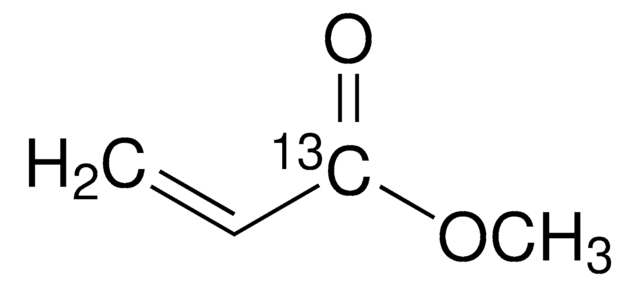M27301
Methylacrylat
99%, contains ≤100 ppm monomethyl ether hydroquinone as inhibitor
Synonym(e):
Methylacrylate
About This Item
Empfohlene Produkte
Dampfdichte
3 (vs air)
Dampfdruck
67.5 mmHg ( 20 °C)
Assay
99%
Form
liquid
Selbstzündungstemp.
874 °F
Enthält
≤100 ppm monomethyl ether hydroquinone as inhibitor
Expl.-Gr.
14.5 %
Brechungsindex
n20/D 1.402 (lit.)
bp
80 °C (lit.)
mp (Schmelzpunkt)
−75 °C (lit.)
Dichte
0.956 g/mL at 25 °C (lit.)
Lagertemp.
2-8°C
SMILES String
COC(=O)C=C
InChI
1S/C4H6O2/c1-3-4(5)6-2/h3H,1H2,2H3
InChIKey
BAPJBEWLBFYGME-UHFFFAOYSA-N
Suchen Sie nach ähnlichen Produkten? Aufrufen Leitfaden zum Produktvergleich
Verwandte Kategorien
Allgemeine Beschreibung
Anwendung
Signalwort
Danger
Gefahreneinstufungen
Acute Tox. 3 Inhalation - Acute Tox. 4 Dermal - Acute Tox. 4 Oral - Aquatic Chronic 3 - Eye Irrit. 2 - Flam. Liq. 2 - Skin Irrit. 2 - Skin Sens. 1 - STOT SE 3
Zielorgane
Respiratory system
Lagerklassenschlüssel
3 - Flammable liquids
WGK
WGK 2
Flammpunkt (°F)
27.0 °F - closed cup
Flammpunkt (°C)
-2.8 °C - closed cup
Persönliche Schutzausrüstung
Eyeshields, Faceshields, Gloves, type ABEK (EN14387) respirator filter
Analysenzertifikate (COA)
Suchen Sie nach Analysenzertifikate (COA), indem Sie die Lot-/Chargennummer des Produkts eingeben. Lot- und Chargennummern sind auf dem Produktetikett hinter den Wörtern ‘Lot’ oder ‘Batch’ (Lot oder Charge) zu finden.
Besitzen Sie dieses Produkt bereits?
In der Dokumentenbibliothek finden Sie die Dokumentation zu den Produkten, die Sie kürzlich erworben haben.
Kunden haben sich ebenfalls angesehen
Artikel
Our strategy is to synthesize mesoporous carbonaceous materials (“Starbons”) using mesoporous expanded starch as the precursor without the need for a templating agent.
RAFT polymerization offers living characteristics to radical polymerization, contributing versatility to reversible deactivation radical polymerization methods.
Unser Team von Wissenschaftlern verfügt über Erfahrung in allen Forschungsbereichen einschließlich Life Science, Materialwissenschaften, chemischer Synthese, Chromatographie, Analytik und vielen mehr..
Setzen Sie sich mit dem technischen Dienst in Verbindung.














![Tris[2-(dimethylamino)ethyl]amin 97%](/deepweb/assets/sigmaaldrich/product/structures/695/792/ee0ff167-22a3-43a7-83a1-6c4908adf0ae/640/ee0ff167-22a3-43a7-83a1-6c4908adf0ae.png)